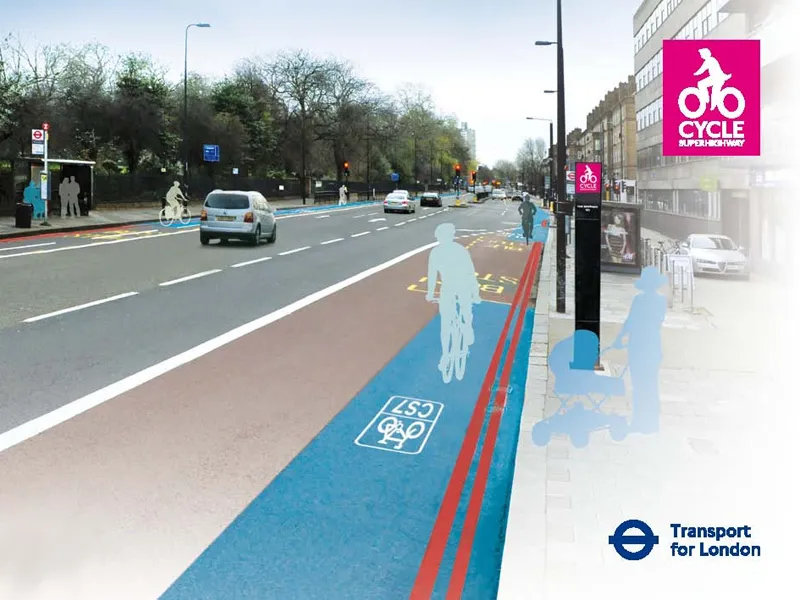Work started today (Tuesday 16 February) on London’s first two Cycle Superhighways. The idea is that they will make it safer and easier to commute by bike between outer and inner London.
The pilot routes, which are the first of 12 Cycle Superhighways planned for the capital, run from Merton to the City via the A24 and A3, and Barking to Tower Gateway via the A13 and Cable Street.
Resurfacing work began today near Westferry DLR station on the Barking to Tower Gateway route, and Transport for London (TfL) will trial new continuous cycle lanes through three junctions on the Merton to City route shortly.
This will involve laying a blue cycle lane through the junction which will continue about 30 metres on either side – but this doesn't mean cyclists can jump red lights.
TfL press officer Nancy Ryder told BikeRadar: "This trial is very much about testing motorists' and cyclists' reactions to the blue surfacing. We're going to be monitoring people's behaviour over six weeks at these sites."
Two of the trial sites are on the A24 in Tooting (the junctions of the A24 with Tooting Bec Road and Longley Road) and the third is on the A3 in Southwark (A3 junction with Union Street).

Artist's impression showing all the Cycle Superhighways measures
As well as installing new cycle lanes and upgrading existing ones, other works scheduled before the routes launch in the summer include:
- Installing advanced stop lines at junctions, so cyclists can wait at lights ahead of motor traffic. Eg. Junction of Clapham Common Southside and Narbonne Avenue.
- Realigning traffic lanes and bus lanes to make busy stretches safer for cyclists. Eg. Southbound section of the A24 at the junction of Kennington Road and Brixton Road.
- Trialling cycle safety mirrors, subject to Department for Transport approval, at junctions. These give drivers of large vehicles better visibility of cyclists when turning left.
- Assessing the impact of reducing the two northbound lanes of the A3 at the Stockwell Gyratory to one lane, allowing the installation of a new segregated cycle lane. A further segregated lane is proposed at the junction parallel to Stockwell Terrace.
- Resurfacing. Eg. Between Newby Place and Naval Row in Poplar.
- Improving the diversionary route around the Elephant and Castle roundabout with better signage and resurfacing some sections.
TFL are also installing 300 new cycle parking spaces along both pilot routes, including outside all Tube stations along the Merton to City route. This is in addition to the extra cycle parking that will installed by the eight London boroughs the routes run through, using £1.49 million that has been allocated by TfL for cycle parking, training and maintenance sessions. In addition, TfL is working with businesses along the routes to encourage cycling among their employees.

Artist's impression of the Cycle Superhighway on the A13 towards the City of London
Mayor of London Boris Johnson said: “The Superhighways, alongside our cycle hire scheme and our huge cycle safety programme, will transform the experience of cycling in the capital. This in turn will help us improve air quality, and tackle pollution and congestion on the transport network."
Of the remaining 10 routes, four will be completed by October 2012 and the remaining six by 2015. The assessment process has now started on the next two proposed routes, from Ilford to Aldgate and Wandsworth Town to Westminster.
The Cycle Superhighways will build on the 107 percent growth in cycle journeys which London has seen since TfL was created in 2000. In the last year alone, there has been a nine percent increase in cycle journeys on London’s major roads.

